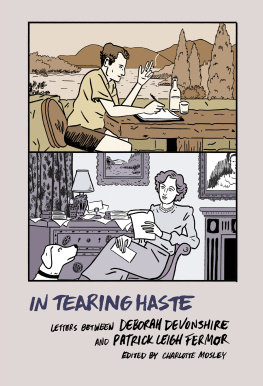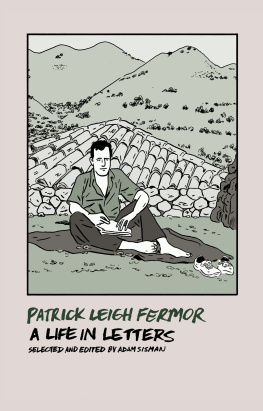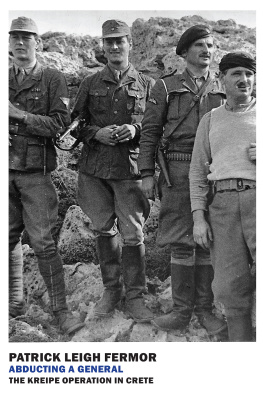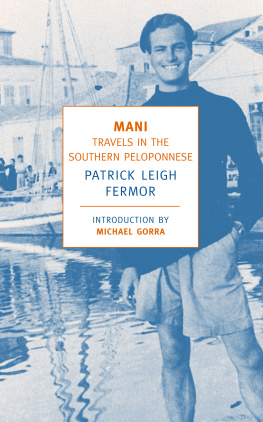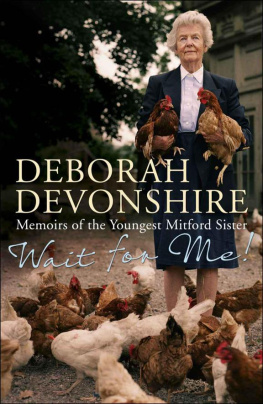DEBORAH DEVONSHIRE
The Dowager Duchess of Devonshire was brought up in Oxfordshire with spells in London. In 1950 her husband, Andrew, the 11th Duke of Devonshire, inherited estates in Yorkshire and Ireland, as well as Chatsworth, the family seat in Derbyshire, and Deborah became chatelaine and housekeeper of one of Englands greatest and best-loved houses. Following her husbands death in 2004, she moved to a village on the Chatsworth Estate where she now lives.
PATRICK LEIGH FERMOR
Patrick Leigh Fermor is of English and Irish descent. After his stormy schooldays, followed by his walk across Europe to Constantinople, he lived and travelled in the Balkans and the Greek Archipelago, acquiring a deep interest in languages and remote places. He joined the Irish Guards, became a liaison officer in Albania, fought in Greece and Crete where, during the German occupation, he returned three times. Disguised as a shepherd he lived for over two years in the mountains, organising the resistance, and led the party that captured and evacuated the German commander, General Kreipe. He was awarded the DSO and OBE, and made Honorary Citizen of Heraklion, and later of Kardamyli and Gytheion. He now lives partly in Greece in the house he and his wife Joan designed and built on the southernmost peninsula, and partly in Worcestershire.
CHARLOTTE MOSLEY
Charlotte Mosley lives in Paris and has worked as a publisher and journalist. She is the editor of Love from Nancy: The Letters of Nancy Mitford, The Letters of Nancy Mitford and Evelyn Waugh and The Mitfords: Letters Between Six Sisters.
In Tearing Haste
Letters Between Deborah Devonshire and Patrick Leigh Fermor
Edited by
Charlotte Mosley
NEW YORK REVIEW BOOKS

New York
THIS IS A NEW YORK REVIEW BOOK
PUBLISHED BY THE NEW YORK REVIEW OF BOOKS
The New York Review of Books
435 Hudson Street, Suite 300
New York, New York 10014
www.nyrb.com
First published in Great Britain in 2008 by John Murray (Publishers) An Hachette UK Company
Copyright in the letters of Deborah Devonshire Deborah Devonshire 2008
Copyright in the letters of Patrick Leigh Fermor Patrick Leigh Fermor 2008
Copyright in the compilation, footnotes and editors note Charlotte Mosley 2008
The photographs are from private collections unless otherwise credited. All rights reserved.
Drawings of the view from Patrick Leigh Fermors house (page xvii) and Lismore Castle (page xxi) by John Craxton
A CIP catalog record for this title is available from the Library of Congress
ISBN 978-1-68137-187-0
v1.0
Cover illustration: Nathan Gelgud
For a complete list of titles, visit www.nyrb.com or write to:
Catalog Requests, NYRB, 435 Hudson Street, New York, NY 10014
Contents
In memory of Joan and Andrew
Acknowledgements
It is unusual for a book of letters to be published during the lifetime of its authors and this one has greatly benefited from their contribution. My first thanks, therefore, are to Debo and Paddy for being unfailingly generous with their time and memories.
I owe a huge debt to Helen Marchant who typed all the letters, not only at record speed but with preternatural skill when it came to de -ciphering Paddys handwriting.
I am particularly grateful to Artemis Cooper, who is preparing a biography of Paddy, and to Olivia Stewart for her help with the photographs.
I would also like to thank the following: Ginnie Airlie, Stuart Band, Anne Pauline de Castries, Caroline Cranbrook, Derry Moore, Katie Edwards, Anne Egerton, Ian Else, Magouche Fielding, the Clerk to the Worshipful Company of Fishmongers, Bridget Flemming, Nicholas Henderson, Hussein Hinnawi, Kate Kee, Jeremy Lewis, Jean-Nol Liaut, Elizabeth Longman, Mary S. Lovell, Michael Mallon, Sophie Caroline de Margerie, Peter Miller, Diane Naylor, Charles Noble, Henri and Sybil dOrigny, Jane Ormsby Gore, Andrew Parker Bowles, Andrew Peppitt, Christine Robinson, Serena Rothschild, Penelope Skarsouli, Mary Soames, Archie Stirling, Mario Testino and Teresa Wells.
Editors Note
Patrick Leigh Fermors first sight of Deborah Mitford left a lasting impression. She did not even notice him. It was at a regimental ball in 1940 when he was a twenty-five-year-old officer in the Intelligence Corps and she the twenty-year-old fiance of Andrew Cavendish, recently commissioned into the Coldstream Guards. She had eyes only for her husband-to-be.
They met again as acquaintances at parties in London in the early 1950s, but their friendship truly blossomed in 1956 when Paddy took up a long-standing invitation to stay with Andrew and Debo by now the Duke and Duchess of Devonshire at Lismore, their magnificent neo-Gothic castle overlooking the Blackwater Valley in County Water-ford, Ireland. This fairy-tale setting with its rich historical associations cast a spell over Paddys romantic spirit, stirring his love of pageantry and heraldry, of wild open country and odd encounters, of archaic language and local lore. He also fell for Debo. It was not an exclusive love he was devoted to Joan Eyres Monsell, the woman who was to become his wife but a deep, platonic attraction between two people who shared youthful high spirits, warmth, generosity and an unstinting enjoyment of life.
Debo was the youngest of the six beautiful Mitford sisters, whose exploits and extreme political opinions made them household names; she was also the most well-adjusted. The familys rather isolated upbringing in the Oxfordshire countryside, immortalised in Nancy Mitfords novels, suited Debo and she considered her childhood to have been happy. Unlike her sisters, she never resented not being sent to school dreaded the idea in fact and followed them into the schoolroom where they were taught by a succession of governesses. From her mother, Lady Redesdale, who after her own mothers death had taken over the running of her fathers household at the age of fourteen, Debo inherited an excellent head for business and a natural talent for organising, qualities that proved useful when, in 1950, Andrew inherited the dukedom and the vast Devonshire estates. In 1959, he and Debo decided to move back into Chatsworth, the familys magnificent house in the Peak District of Derbyshire, which had not been redecorated since the First World War and had been occupied by a girls school during the Second. Andrew devised a way of paying off the death duties that were owing after his fathers death, amounting to some eighty per cent of the estate, and Debo threw herself with gusto into restoring the house and reopening it fully to the public. She started shops and a restaurant, a childrens playground and a farmyard, helping to transform a debt-ridden inheritance into a thriving enterprise. In the early 1980s, she embarked rather unexpectedly given her claim never to have read a book on a writing career. The House, an account of the restoration work, was the first of ten highly individual books she has produced about Chatsworth and the estate.
When Debo and Paddy began to write to each other, in 1954, Paddys reputation rested on an impressive war record and two books: The Travellers Tree: A Journey through the Caribbean Islands and The Violins of Saint-Jacques, his only novel. He had spent most of the war in Crete where, after the Allied retreat from the island in 1941, he was among a small number of British agents who stayed to help organise resistance to the Nazi occupation. In 1944 he led the successful abduction of Major-General Heinrich Kreipe, the German commander in Crete, a daring operation that won him the DSO. The exploit became famous, not because Paddy himself has ever written or even talked much about it, but because in 1950 his second-in-command, William Stanley Moss, published a best-selling book,

